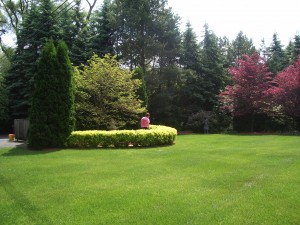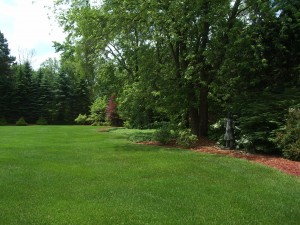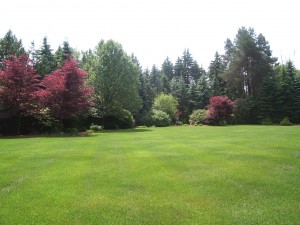A perfect summer day is when the sun is shining, the breeze is blowing, the birds are singing, and the lawn mower is broken.
~James Dent
After some playful exchange of information about turfgrass on our Two Women and a Hoe® Facebook Fan Page, I asked TC Conner if he would enlighten me on the benefits of turfgrass and he graciously complied.
For the record, I DO NOT have anything against lawn or tuffgrass! I just don’t want to maintain it, not now anyway! In fact, when we are designing landscapes and gardens for clients, we find ourselves removing sod to ADD gardens. I cannot EVER recall incorporating lawn or turfgrass into a design and that’s the truth. No apologies.
On this particular day, TC Conner struck a chord in me and I was overtly curious to learn about the environmental benefits of lawn and turfgrass. Fortunately, TC agreed to contribute a guest post and I am glad he did! Little did I know, I had a lot to learn about turf!
P.S. That’s me in the pink T-shirt below pruning hedges at a client’s 5+ acres. The other pics on this post are the same client’s property. My disclaimer: it’s a lovely place to work, turfgrass and all!
Without further ado, let’s hear from TC Conner on turfgrass:
Why is it that some folks just seem to be so set against lawns these days? I can understand some aspects of the anti-lawn rhetoric, for example, urging folks with small yards to get rid of grass in exchange for edible flowers and a veggie garden. But it’s not really all that bad to have a front or back yard with a carpet of turfgrass to play on. After all, grass has been around since, well, ever since God made dirt!
Writing in “Second Nature: A Gardener’s Education” (Grove Press, 1991), Michael Pollan gives us reason to ponder why we’re in love with our lawns: “Perhaps the allure of the lawn is in the genes. The sociobiologists think so: they’ve gone so far as to propose a ‘Savanna Syndrome’ to explain our fondness for grass.” I’m thinking of the African savannas, Pollan continues: “Encoded in our DNA is a preference for an open grassy landscape resembling the shortgrass savannas of Africa on which we evolved and spent our first few thousand years.” And for those who don’t believe in evolution, think of the grass in the Garden of Eden.
Hold on a minute you might say, Pollan’s book is a bit outdated, in 1991 the urbanites were just beginning to rethink their role in the natural world, edible landscapes weren’t as popular then as now. Farmers too played a much larger role in growing a lot of what we ate back then. With the demise of small family farms, growing produce in the yard instead of grasses seems like a natural progression, which is all well and good. But some of us still enjoy keeping a lawn and I’m not giving it up for a wildflower meadow or an oversized veggie garden. (And before you even accuse me, I DO NOT have anything against wildflower meadows, I just don’t want one in my back yard, not now anyway.)
Let’s think for a minute about the following statement from Dr. Ranajit Sahu: “With proper education and awareness, it is now possible to retain the benefits of lawns and turfgrass areas while minimizing or eliminating the negatives associated with water overuse and other harmful practices – leading to an experience that affords community, lifestyle and environmental benefits.” (Dr. Sahu teaches classes in air pollution and environmental health risk assessment at Loyola Marymount University’s Frank R. Seaver College of Science and Engineering.)
Dr. Sahu mentions lawns having benefits, there was a time that most gardeners thought the same thing, and some still do. I believe the anti-lawn crowd (which includes many gardeners) needs to be reminded about the good things grass provides. And I’ll mention just a few; this little testament is already getting longer than I thought it’d be.
- The “sea of green” we call our lawns is one of the best and easiest to maintain groundcovers you’ll ever grow.
- Grass filters water and recharges the watershed.
- Lawns, often called “green space” when referred to in research reports, reduce storm water runoff. An average suburban green space lot of about 10,000 square feet absorbs 6,000 gallons of rainwater (Environmental Health Research Foundation’s “Benefits of Green Space – Recent Research, April 25, 2011).
I could go on and on naming numerous other benefits of lawns, but I won’t. Suffice to say that I think lawns are very beneficial, and those of us who keep them do so for good reasons. Barefooting through a yard full of grass, dandelions, and white clover, dodging honeybees (God help them!) on a hot summer day is stingingly invigorating. But if you prefer to swap that out for a yard full of more zucchini and beans, have at it! I’ll keep on barefooting around my lush lawn, “Savannah Syndrome” or not!
Special thanks to Jim Novak, Public Relations Manager, Turfgrass Producers International, for a couple of PDF documents stating facts and figures (available by request).
TC Conner is a freelance writer, master gardener, amateur photographer, musician, and author. For reprints of the above article, copy and paste!
Here’s what I learned: It’s a wonderful world to have the freedom to surround ourselves with the things we love, without judgement. Thank you, TC, from the bottom of my heart!
May all your TURFGRASS grow,





